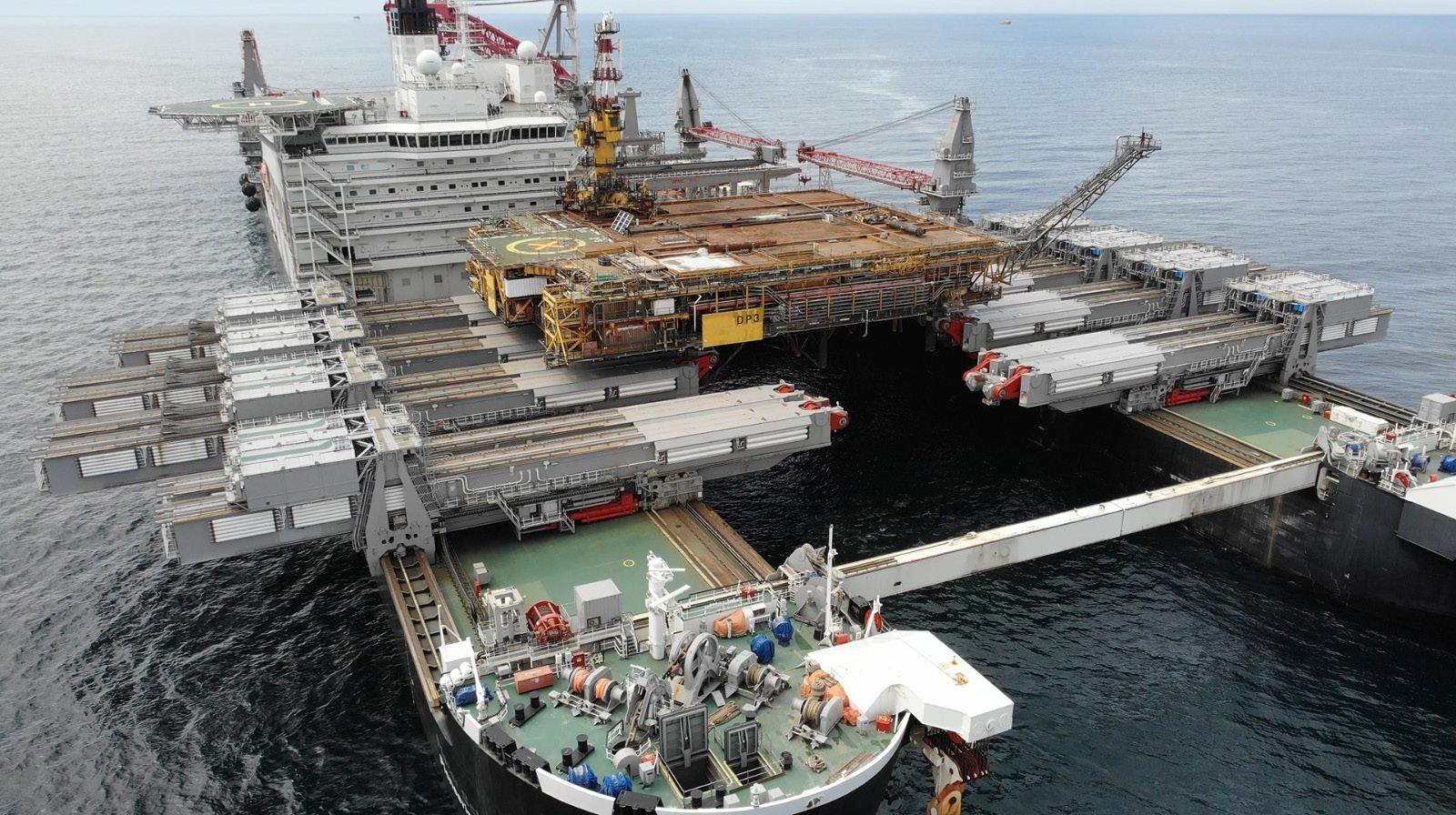Offshore - Demolition Allseas completes Morecombe demolition The 403,352 gt offshore demolition vessel Pioneering Spirit has successfully executed the single-lift removal of the former DP3 gas production topsides from Spirit Energy’s Morecambe Bay development in the East Irish Sea. This follows the removal of the DP4 topsides and subsequent transport to the UK in April. The vessel’s motion-compensated lift technology proved hugely effective in the shallow waters of Morecambe Bay, renowned for strong currents and challenging tidal conditions. For both the DP3 and DP4 operations, it was a matter of hours between arrival in the field and safe execution of the topsides’ lifts. The Pioneering Spirit delivered the 5,450 tonne DP3 installation to a new disposal and recycling facility at the Fife Energy Park, Scotland, where it will be reunited with the Allseas’ scope covers engineering, preparation, removal and disposal of two 11,000 tonne normally unmanned installations (NUMIs) and 1,000 tonnes of connected subsea infrastructure. The latter, including wellheads, pipelines and umbilicals, was removed by Allseas’ 12,397 gt construction support vessel Oceanic in a complicated sequence of approximately 180 lifts. Pioneering Spirit will return to Morecambe Bay to remove the DP3 and DP4 supporting jackets in 2023. Operational since 2016, the DP3 and DP4 topsides removals for Spirit Energy is the vessel’s first heavy lift assignment outside the North Sea. Still a relative newcomer to the offshore heavy lift market, Pioneering Spirit has already installed and removed over 200,000 tonnes of platform weight, moving the work onshore where it is safer and quicker. Equipped with motion compensation technology and capable of lifting entire offshore structures up to 48,000 tonnes in just a few hours, Pioneering Spirit spends significantly less time in the field compared to conventional heavy lift barges, which results in drastically reduced emissions footprint. Earlier this year Allseas completed the Tyra Redevelopment for Total Denmark, also using the Pioneering Sprit carried out in the North Sea at a depth of 42 m. The scope of work comprised: • Engineering, preparation, removal, transport and load-in of: 14,000 tonne Tyra East Alpha and 7,800 t Tyra West Alpha platform topsides 5,000 tonne Tyra East Alpha and 2,900 t Tyra West Alpha platform jackets 1,200 tonne Tyra West Delta and 900 t Tyra East Delta flare jackets 1,400 tonne K and 1,000 t IPF modules • Pre-lift preparation work including removal and separation of under-deck caissons • Design, fabrication and installation of bearing blocks to accommodate “horseshoe” lifting tools • Leg cutting • Transfer of topsides and modules from Pioneering Spirit to the offshore barge Iron Lady and load-in to M.A.R.S. recycling yard at Frederikshavn, Denmark • Transfer of flare jackets from Pioneering Spirit to Iron Lady and load-in to Sagro recycling yard at Vlissingen, the Netherlands
Page 68 – www.shipandoffshorerepair.com
The Pioneering Spirit removing the Morecombe Field structure
Nerida removes the Hutton tension leg The giant Hutton tension leg platform, a landmark in the North Sea oil industry, has made her final journey. Hutton was the world’s first tension leg platform (TLP) permanently moored to the sea bed, a design that offers good vertical stability and greater control over production. The 30,000 tonne platform, 48 m high, was towed 5 miles (8 kms) across the Cromarty Firth to Queen’s Dock in Invergordon where she will be recycled over the next 12 months. The Hutton was in operation for 20 years in the Hutton oilfield between Shetland and Norway, before being decommissioned and returning to the Cromarty Firth in 2009. Nerida, an offshore oil and gas transport specialist, along with its partner Messiah Decommissioning acquired the Hutton from its previous owners in 2021. The purchase was brokered by Simon Worden at Offshore Shipbrokers. Jon Townley, Managing Director of Nerida, said, “We are delighted to have cleared all the regulatory hurdles and to move ahead with the dismantling of the structure. Queen’s Dock was the natural choice because of its outstanding facilities and experience in this field. One of our key priorities was to ensure the jobs created from this process would remain in the UK. “This is a good example of the circular economy as the hull was built at Highland Fabricators in Nigg and the deck section was built at the McDermott yard in Ardersier. The two sections were assembled in the Moray firth off Findhorn, so it is fitting that the platform should finish its life in Invergordon.” The Hutton platform was in operation for 20 years in the Hutton oilfield between Shetland and Norway, before being decommissioned and returning to the Cromarty Firth in 2009. Hutton was the world’s first tension leg platform (TLP) permanently moored to the sea bed, a design that offers good vertical stability and greater control over production. The process of lifting the 500 tonnes of chains and anchors and towing the platform 5 miles to Invergordon took 36 hours and involved six tugs accompanied by a rescue boat. Nerida arranged the tow to the dock and have now handed the rig over Messiah whose directors, Tony O’Sullivan and Steven Regan have mobilised their extensive array of specialised equipment and highly experienced management team to handle the decommissioning and recycling. Bob Buskie, Chief Executive of the Port of Cromarty Firth, said,












